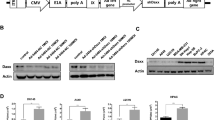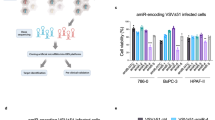Abstract
Oncolytic adenoviral mutants have considerable activity in ovarian cancer. However, the mechanisms by which they induce cell death remain uncertain. dl922-947, which contains a 24 bp deletion in E1A CR2, is more potent than both E1A wild-type adenoviruses and the E1B-55K deletion mutant dl1520 (Onyx-015). We investigated the mode of death induced by three E1A CR2-deleted replicating adenoviruses in models of ovarian cancer and also the importance of E3 11.6 (adenovirus death protein) in determining this mode of death. Ovarian cancer cells were infected with dl922-947 (E3 11.6+) and dlCR2 (E3 11.6−). We also generated dlCR2 tSmac, which also encodes the gene for processed Smac/DIABLO. Classical apoptosis does not occur in adenoviral cell death and there is no role for mitochondria. Expression of Smac/DIABLO does not enhance cytotoxicity nor increase apoptotic features. A role for cathepsins and lysosomal membrane permeability was excluded. Autophagy is induced, but is not the mode of death and may act as a cell survival mechanism. There is no evidence of pure necrosis, while the presence of E3 11.6 does not modulate the mode or extent of cell death. Thus, E1A CR2-deleted oncolytic adenoviral cytotoxicity in ovarian cancer may define a novel mode of programmed cell death.
This is a preview of subscription content, access via your institution
Access options
Subscribe to this journal
Receive 50 print issues and online access
$259.00 per year
only $5.18 per issue
Buy this article
- Purchase on Springer Link
- Instant access to full article PDF
Prices may be subject to local taxes which are calculated during checkout





Similar content being viewed by others
References
Abou El Hassan MAI, van der Meulen-Muileman I, Abbas S, Kruyt FAE . (2004). Conditionally replicating adenoviruses kill tumor cells via a basic apoptotic machinery-independent mechanism that resembles necrosis-like Programmed Cell Death. J Virol 78: 12243–12251.
Amaravadi RK, Yu D, Lum JJ, Bui T, Christophorou MA, Evan GI et al. (2007). Autophagy inhibition enhances therapy-induced apoptosis in a Myc-induced model of lymphoma. J Clin Invest 117: 326–336.
Baines CP, Kaiser RA, Purcell NH, Blair NS, Osinska H, Hambleton MA et al. (2005). Loss of cyclophilin D reveals a critical role for mitochondrial permeability transition in cell death. Nature 434: 658–662.
Bampton ET, Goemans CG, Niranjan D, Mizushima N, Tolkovsky AM . (2005). The dynamics of autophagy visualized in live cells: from autophagosome formation to fusion with endo/lysosomes. Autophagy 1: 23–36.
Bauvy C, Gane P, Arico S, Codogno P, Ogier-Denis E . (2001). Autophagy delays sulindac sulfide-induced apoptosis in the human intestinal colon cancer cell line HT-29. Exp Cell Res 268: 139–149.
Caro LH, Plomp PJ, Wolvetang EJ, Kerkhof C, Meijer AJ . (1988). 3-Methyladenine, an inhibitor of autophagy, has multiple effects on metabolism. Eur J Biochem 175: 325–329.
Castino R, Pace D, Demoz M, Gargiulo M, Ariatta C, Raiteri E et al. (2002). Lysosomal proteases as potential targets for the induction of apoptotic cell death in human neuroblastomas. Int J Cancer 97: 775–779.
Cereghetti GM, Scorrano L . (2006). The many shapes of mitochondrial death. Oncogene 25: 4717–4724.
Chiou SK, Tseng CC, Rao L, White E . (1994). Functional complementation of the adenovirus E1B 19-kilodalton protein with Bcl-2 in the inhibition of apoptosis in infected cells. J Virol 68: 6553–6566.
Fueyo J, Alemany R, Gomez-Manzano C, Fuller GN, Khan A, Conrad CA et al. (2003). Preclinical characterization of the antiglioma activity of a tropism-enhanced adenovirus targeted to the retinoblastoma pathway. J Natl Cancer Inst 95: 652–660.
Fueyo J, Gomez-Manzano C, Alemany R, Lee P, McDonnell T, Mitlianga P et al. (2000). A mutant oncolytic adenovirus targeting the Rb pathway produces anti-glioma effect in vivo. Oncogene 19: 2–12.
Gross A, McDonnell JM, Korsmeyer SJ . (1999). BCL-2 family members and the mitochondria in apoptosis. Genes Dev 13: 1899–1911.
Hall A, Dix B, O'Carroll S, Braithwaite A . (1998). p53-dependent cell death/apoptosis is required for a productive adenovirus infection. Nat Med 4: 1068–1072.
He T-C, Zhou S, Da Costa L, Yu J, Kinzler K, Vogelstein B . (1998). A simplified system for generating recombinant adenoviruses. Proc Natl Acad Sci USA 95: 2509–2514.
Heise C, Hermiston T, Johnson L, Brooks G, Sampson-Johannes A, Williams A et al. (2000). An adenovirus E1A mutant that demonstrates potent and selective systemic anti-tumoral efficacy. Nat Med 6: 1134–1139.
Ito H, Aoki H, Kuhnel F, Kondo Y, Kubicka S, Wirth T et al. (2006). Autophagic cell death of malignant glioma cells induced by a conditionally replicating adenovirus. J Natl Cancer Inst 98: 625–636.
Jiang H, Gomez-Manzano C, Aoki H, Alonso MM, Kondo S, McCormick F et al. (2007). Examination of the therapeutic potential of Delta-24-RGD in brain tumor stem cells: role of autophagic cell death. J Natl Cancer Inst 99: 1410–1414.
Kroemer G, El-Deiry WS, Golstein P, Peter ME, Vaux D, Vandenabeele P et al. (2005). Classification of cell death: recommendations of the Nomenclature Committee on Cell Death. Cell Death Differ 12 (Suppl 2): 1463–1467.
Lelli Jr JL, Becks LL, Dabrowska MI, Hinshaw DB . (1998). ATP converts necrosis to apoptosis in oxidant-injured endothelial cells. Free Radic Biol Med 25: 694–702.
Levine B, Yuan J . (2005). Autophagy in cell death: an innocent convict? J Clin Invest 115: 2679–2688.
Leyton J, Lockley M, Aerts JL, Baird SK, Aboagye EO, Lemoine NR et al. (2006). Quantifying the activity of adenoviral E1A CR2 deletion mutants using renilla luciferase bioluminescence and 3′-deoxy-3′-[18F]fluorothymidine positron emission tomography imaging. Cancer Res 66: 9178–9185.
Lockley M, Fernandez M, Wang Y, Li NF, Conroy SE, Lemoine NR et al. (2006). Activity of the adenoviral E1A deletion mutant dl922-947 in ovarian cancer: comparison with adenovirus wild-type, bioluminescence monitoring and intraperitoneal delivery in icodextrin. Cancer Res 66: 989–998.
McNeish IA, Bell S, McKay T, Tenev T, Marani M, Lemoine NR . (2003). Expression of Smac/DIABLO in ovarian carcinoma cells induces apoptosis via a caspase-9-mediated pathway. Exp Cell Res 286: 186–198.
McNeish IA, Tenev T, Bell S, Marani M, Vassaux G, Lemoine N . (2001). Herpes simplex virus thymidine kinase/ganciclovir-induced cell death is enhanced by co-expression of caspase-3 in ovarian carcinoma cells. Cancer Gene Ther 8: 308–319.
Opipari Jr AW, Tan L, Boitano AE, Sorenson DR, Aurora A, Liu JR . (2004). Resveratrol-induced autophagocytosis in ovarian cancer cells. Cancer Res 64: 696–703.
Rao L, Debbas M, Sabbatini P, Hockenbery D, Korsmeyer S, White E . (1992). The adenovirus E1A proteins induce apoptosis, which is inhibited by the E1B 19-kDa and Bcl-2 proteins. Proc Natl Acad Sci USA 89: 7742–7746.
Robert A, Miron M-J, Champagne C, Gingras M-C, Branton PE, Lavoie JN . (2002). Distinct cell death pathways triggered by the adenovirus early region 4 ORF 4 protein. J Cell Biol 158: 519–528.
Sherr CJ, McCormick F . (2002). The RB and p53 pathways in cancer. Cancer Cell 2: 103–112.
Steegenga WT, Riteco N, Jochemsen AG, Fallaux FJ, Bos JL . (1998). The large E1B protein together with the E4orf6 protein target p53 for active degradation in adenovirus infected cells. Oncogene 16: 349–357.
Stroikin Y, Dalen H, Loof S, Terman A . (2004). Inhibition of autophagy with 3-methyladenine results in impaired turnover of lysosomes and accumulation of lipofuscin-like material. Eur J Cell Biol 83: 583–590.
Subramanian T, Vijayalingam S, Chinnadurai G . (2006). Genetic identification of adenovirus type 5 genes that influence viral spread. J Virol 80: 2000–2012.
Talloczy Z, Jiang W, Virgin HW, Leib DA, Scheuner D, Kaufman RJ et al. (2002). Regulation of starvation- and virus-induced autophagy by the eIF2alpha kinase signaling pathway. Proc Natl Acad Sci USA 99: 190–195.
Terman A, Dalen H, Eaton JW, Neuzil J, Brunk UT . (2003). Mitochondrial recycling and aging of cardiac myocytes: the role of autophagocytosis. Exp Gerontol 38: 863–876.
Tollefson AE, Ryerse JS, Scaria A, Hermiston TW, Wold WS . (1996). The E3-11.6-kDa adenovirus death protein (ADP) is required for efficient cell death: characterization of cells infected with adp mutants. Virology 220: 152–162.
Yaginuma Y, Hayashi H, Kawai K, Kurakane T, Saitoh Y, Kitamura S et al. (1997). Analysis of the Rb gene and cyclin-dependent kinase 4 inhibitor genes (p16INK4 and p15INK4B) in human ovarian carcinoma cell lines. Exp Cell Res 233: 233–239.
Ying B, Wold WSM . (2003). Adenovirus ADP protein (E3-11.6K), which is required for efficient cell lysis and virus release, interacts with human MAD2B. Virology 313: 224–234.
Zong WX, Ditsworth D, Bauer DE, Wang ZQ, Thompson CB . (2004). Alkylating DNA damage stimulates a regulated form of necrotic cell death. Genes Dev 18: 1272–1282.
Acknowledgements
This research was funded by Cancer Research UK (grant C9423/A4119). We acknowledge the excellent technical assistance of Ken Blight in the Electron Microscopy Department, Cancer Research UK London Research Institute.
Author information
Authors and Affiliations
Corresponding author
Additional information
Supplementary Information accompanies the paper on the Oncogene website (http://www.nature.com/onc).
Supplementary information
Rights and permissions
About this article
Cite this article
Baird, S., Aerts, J., Eddaoudi, A. et al. Oncolytic adenoviral mutants induce a novel mode of programmed cell death in ovarian cancer. Oncogene 27, 3081–3090 (2008). https://doi.org/10.1038/sj.onc.1210977
Received:
Revised:
Accepted:
Published:
Issue Date:
DOI: https://doi.org/10.1038/sj.onc.1210977
Keywords
This article is cited by
-
Biological causes of immunogenic cancer cell death (ICD) and anti-tumor therapy; Combination of Oncolytic virus-based immunotherapy and CAR T-cell therapy for ICD induction
Cancer Cell International (2022)
-
Carvedilol targets β-arrestins to rewire innate immunity and improve oncolytic adenoviral therapy
Communications Biology (2022)
-
Understanding and addressing barriers to successful adenovirus-based virotherapy for ovarian cancer
Cancer Gene Therapy (2021)
-
A novel bladder cancer - specific oncolytic adenovirus by CD46 and its effect combined with cisplatin against cancer cells of CAR negative expression
Virology Journal (2017)
-
RIPK3 promotes adenovirus type 5 activity
Cell Death & Disease (2017)



